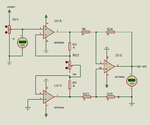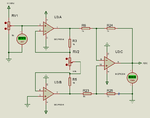Okada
Banned
Is this design good to measure 2mV to 8mV ? I am using CZL928E Load Cell.
https://hlhsensor.en.made-in-china....X/China-Micro-Weighing-Load-Cell-Czl928e.html
Test the attached Proteus Simulation. Opens in Proteus 8.5 SP1 or later.
I had to measure 2mV to 6mV and display it a 0 to 100 (percentage) but I designed to measure 2mV to 8mV. For people who doesn't have Proteus I have attached the circuit in image format.
https://hlhsensor.en.made-in-china....X/China-Micro-Weighing-Load-Cell-Czl928e.html
Test the attached Proteus Simulation. Opens in Proteus 8.5 SP1 or later.
I had to measure 2mV to 6mV and display it a 0 to 100 (percentage) but I designed to measure 2mV to 8mV. For people who doesn't have Proteus I have attached the circuit in image format.



